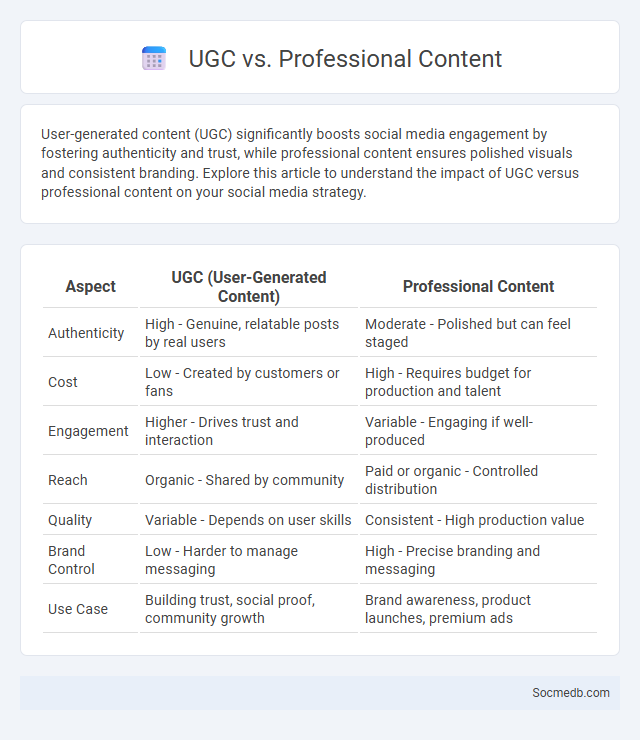
Photo illustration: UGC vs Professional Content
User-generated content (UGC) significantly boosts social media engagement by fostering authenticity and trust, while professional content ensures polished visuals and consistent branding. Explore this article to understand the impact of UGC versus professional content on your social media strategy.
Table of Comparison
| Aspect | UGC (User-Generated Content) | Professional Content |
|---|---|---|
| Authenticity | High - Genuine, relatable posts by real users | Moderate - Polished but can feel staged |
| Cost | Low - Created by customers or fans | High - Requires budget for production and talent |
| Engagement | Higher - Drives trust and interaction | Variable - Engaging if well-produced |
| Reach | Organic - Shared by community | Paid or organic - Controlled distribution |
| Quality | Variable - Depends on user skills | Consistent - High production value |
| Brand Control | Low - Harder to manage messaging | High - Precise branding and messaging |
| Use Case | Building trust, social proof, community growth | Brand awareness, product launches, premium ads |
Understanding UGC, Professional Content, and User-Generated Content
User-generated content (UGC) encompasses posts, reviews, photos, and videos created by consumers, offering authentic insights and driving engagement on social media platforms. Professional content, produced by brands or influencers, maintains high quality and strategic messaging to promote products, services, or brand identity. Understanding the balance between UGC and professional content enables effective marketing strategies that leverage authenticity while maintaining brand consistency.
Key Differences Between UGC and Professional Content
User-generated content (UGC) is created by everyday users sharing authentic experiences, while professional content is produced by experts or brands with high-quality visuals and strategic messaging. UGC often drives trust and engagement due to its genuine nature, whereas professional content ensures consistency, brand alignment, and polished presentation. Your social media strategy should balance both to maximize audience connection and brand credibility.
Benefits of UGC in Digital Marketing
User-generated content (UGC) significantly enhances digital marketing by boosting brand authenticity and fostering trust among consumers. It increases engagement rates on social media platforms and drives higher conversion rates due to its relatable and genuine nature. Marketers leverage UGC to reduce content creation costs while amplifying reach through organic sharing and community involvement.
Professional Content: Strengths and Limitations
Professional content on social media enhances brand authority by showcasing industry expertise and facilitating targeted networking opportunities. High-quality posts, such as whitepapers, webinars, and case studies, build credibility and foster trust among niche audiences. However, limitations include the challenge of maintaining content relevance amid platform algorithms favoring brevity and visual appeal, potentially reducing deep engagement.
The Role of Authenticity in User-Generated Content
Authenticity in user-generated content on social media significantly boosts engagement and trust among audiences, making your brand stand out in a crowded digital landscape. Genuine posts, reviews, and testimonials resonate more deeply with users, fostering loyalty and encouraging organic sharing. By prioritizing authentic content, you harness the power of real experiences to create meaningful connections and enhance your social media presence.
Impact on Audience Engagement and Trust
Social media significantly shapes audience engagement by enabling real-time interactions and personalized content delivery that fosters a sense of community and connection. Your brand's transparency and consistent communication on these platforms build trust, encouraging loyal followers who are more likely to advocate and share your message. Strategies that leverage authentic storytelling and responsive feedback loops enhance credibility and deepen audience relationships in a digital landscape.
Costs and Resource Considerations
Allocating budget for social media involves expenses such as content creation, paid advertising, and social media management tools, which can significantly impact overall marketing costs. Businesses must consider the time and personnel required to maintain active engagement, analyze metrics, and respond to audience interactions effectively. Resource allocation extends to training staff on platform updates and trends, ensuring optimized performance without overspending or underutilizing available assets.
Content Quality: UGC vs. Professional Production
Content quality on social media significantly impacts engagement and reach, with user-generated content (UGC) offering authenticity and relatability that audiences trust. Professional production delivers polished visuals and clear messaging, enhancing brand credibility and attracting wider demographics. You should balance UGC's genuine connection with the high standards of professional content to maximize social media effectiveness.
Choosing the Right Content Strategy for Your Brand
Choosing the right content strategy for your brand involves analyzing audience demographics, platform algorithms, and engagement metrics to tailor posts effectively. High-quality visuals, authentic storytelling, and consistent posting schedules boost brand visibility and foster genuine connections. Your approach should align with business goals while adapting to evolving trends and user preferences to maximize impact.
Future Trends: UGC and Professional Content Evolution
The future of social media centers on the dynamic evolution of user-generated content (UGC) and professional content, with algorithms increasingly prioritizing authenticity and engagement metrics to drive visibility. Emerging trends show a rise in hybrid content models where influencers and brands collaborate to create more relatable yet polished materials, leveraging AI tools for content personalization and real-time analytics. Platforms are also investing in immersive experiences such as augmented reality (AR) and virtual reality (VR), enabling both everyday users and professionals to produce innovative, interactive posts that deepen community connections and enhance user retention.
 socmedb.com
socmedb.com